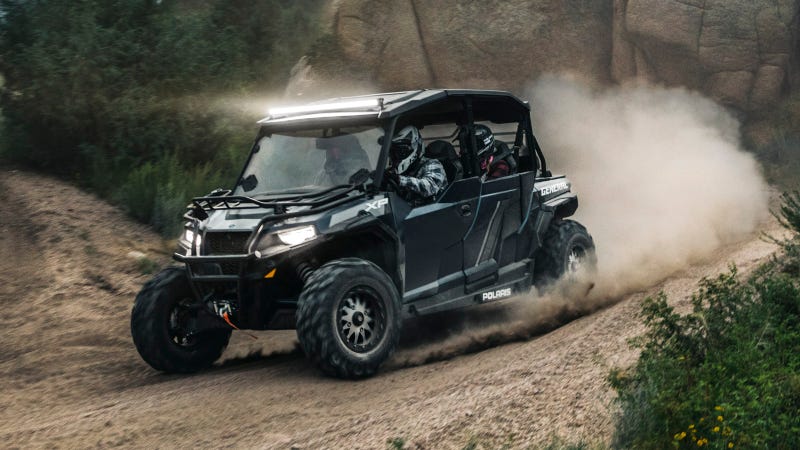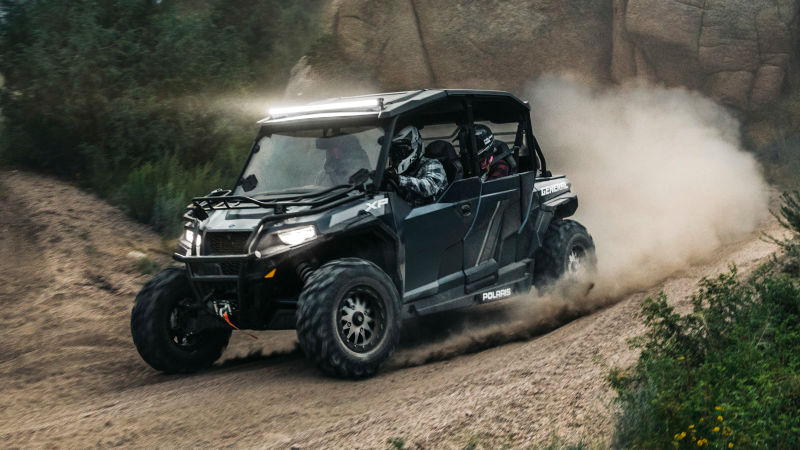
 Truck YeahThe trucks are good!
Truck YeahThe trucks are good!The 2020 Polaris General XP 1000 is an off-road buggy designed to have a useful amount of cargo capacity as well as performance capabilities that make it fun to drive. Polaris calls this a crossover, because it’s landing in a space between the two main types of UTVs: sporty and agricultural.
You might be familiar with the concept of a “crossover SUV,” a vehicle designed to appeal to people who want large-vehicle utility with car-like road manners, and also one of the most popular classes of personal conveyance.
Well, when we’re talking UTVs, “crossover” means this:

Advertisement
UTVs (“Utility Task Vehicles” or “Utility Terrain Vehicles” depending on who you ask), also known as SxSs (“Side-by-Side”) are those cool little buggies people use on farms and in off-road racing. They’re popular in the recreational desert driving scene, because they can go very fast compared to a modified truck over southwestern terrain for, generally speaking, a lot less money.
Vocational UTVs are slow and stout, with cargo trays like little pickup trucks and sometimes even a power take-off to run farm implements. A couple of decades ago, these were the only type of UTVs that existed.
Advertisement
But around the end of the 2000s, companies started realizing that they could offer extreme off-road performance for a relatively low price by applying desert racing suspension concepts to the small packaging of a UTV. The 2008 Polaris RZR is largely considered to be the first “performance UTV,” though you could argue that sandrails and dune buggies were basically executing the same concept in the ’60s.
Except, they weren’t really, because UTVs like today’s RZR, Can-Am Maverick and Textron/Arctic Cat Wildcat are more technologically advanced than scratch-made sand bashers of the past. Ergo, they’re smoother and faster. Plus, you could and can easily find a UTV practically ready to roll out of the showroom and into Baja’s worst terrain at plenty of powersports dealerships.
Advertisement
Anyway, all this to say, most modern UTVs usually look like off-road speed demons or industrial workhorses, the difference being engine tuning and architecture, suspension geometry in particular.

Advertisement
Combining utility with performance the way the General or rival Can-Am Defender do is not a new or revolutionary concept, but I had forgotten this balanced style of UTV still existed until Polaris sent me a press release on about this revised-for-2020 General. And I dig the look: aggressive performance suspension down below, bigger cargo tray out back.
Whether or not the 2020 General is a good execution remains to be seen, but, it sure looks cool. Though I’d be remiss if I didn’t mention that I think all UTVs are dangerous and scary after squishing my hand crashing one.
Advertisement
Spec claims haven’t been completely released as I write this, but Polaris claims the General’s got 100 horsepower and a healthy 13.5-inches of ground clearance, thanks in part to 30-inch tires. The UTV can reportedly tow 1,500 pounds.
UTVs are cheaper than trucks because they don’t have the same creature comforts (nor do they have to comply with the same safety regulations) but the General does have a 7-inch infotainment system with Rockford Fosgate-branded speakers.
Advertisement
Polaris wants about $23,000 for a base 2020 General, with the four-seater starting around $25,000. I’m sure these would run circles off-road around a pickup at the same price point, but, I think I’d rather take the bumps slower in a traditional truck myself.













